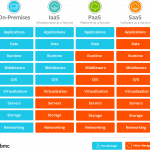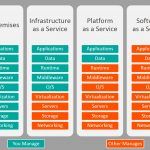| |
While a new era of artificial intelligence (AI) may currently dominate tech headlines, cloud computing remains a hot and pervasive topic to this day. As you consider evolving your business more to the cloud, whether for application or infrastructure deployment, it is more important than ever to understand the differences and advantages of the various cloud services.
Although as-a-service types continue to grow, there are usually three core models of cloud service to consider and compare:
For each of these, we’ll look at the concept, benefits, and variances. We’ll also help you understand the key differences among SaaS, PaaS, and IaaS, so you can choose an approach that’s right for your organization.
(More interested in cloud setup? Learn more about public, private, and hybrid cloud differences.)
Key differences
Common examples of SaaS, PaaS, and IaaS
| Platform Type | Common Examples |
| SaaS | Google Workspace, Dropbox, Salesforce, Cisco WebEx, Concur, GoToMeeting |
| PaaS | Amazon Web Services (AWS) Elastic Beanstalk, Windows Azure, Heroku, Force.com, Google App Engine, Apache Stratos, Red Hat OpenShift |
| IaaS | DigitalOcean, Linode, Rackspace, AWS, Cisco Metapod, Microsoft Azure, Google Compute Engine (GCE) |
SaaS: Software as a service
Software as a service (SaaS), also known as cloud application services, represents the most commonly utilized option for businesses in the cloud market. SaaS leverages the internet to deliver applications, which are managed by a third-party vendor, to its users. A majority of SaaS applications run directly through your web browser, which means they do not require any downloads or installations on the client side.
SaaS delivery
Due to its web-delivery model, SaaS eliminates the need to have IT staff download and install applications on each individual computer. With SaaS, vendors manage all potential technical issues, such as data, middleware, servers, and storage, resulting in streamlined maintenance and support for the business customer.
SaaS advantages
SaaS provides numerous advantages to employees and companies by greatly reducing the time and money spent on tedious tasks, such as installing, managing, and upgrading software. This frees up time for technical staff to spend on bustiness-critical issues within the organization.
SaaS characteristics
There are a few ways to help you determine when SaaS is being utilized:
- Managed from a central location
- Hosted on a remote server
- Accessible over the internet
- Users not responsible for hardware or software updates
When to use SaaS
SaaS may be the most beneficial option in several situations, including:
- Startups or small companies that need to launch e-commerce quickly and don’t have time for server issues or complex on-premises software
- Short-term projects that require quick, easy, and affordable collaboration
- Applications that aren’t needed too often, such as tax software
- Applications that need both web and mobile access
SaaS limitations and concerns
- Interoperability. Integration with existing apps and services can be a major concern if the SaaS application is not designed to follow open standards for integration. In this case, organizations may need to design their own integration systems or reduce dependencies with SaaS services, which may not always be possible.
- Vendor lock-in. Vendors may make it easy to join a service and difficult to get out of it. For instance, the data may not be portable—technically or cost-effectively—across SaaS applications from other vendors without incurring significant cost or in-house engineering rework. Not every vendor follows standard APIs, protocols, and tools, yet the features could be necessary for certain business tasks.
- Lack of integration support. Many organizations require deep integrations with on-premises applications, data, and services. The SaaS vendor may offer limited support in this regard, forcing organizations to invest internal resources in designing and managing integrations. The complexity of integrations can further limit how the SaaS app or other dependent services can be used.
- Data security. Large volumes of data may have to be exchanged with the backend data centers of SaaS applications in order to perform the necessary software functionality. Transferring sensitive business information to public, cloud-based SaaS services may result in compromised security and compliance, in addition to incurring significant cost for migrating large data workloads.
- Customization. SaaS applications offer minimal customization capabilities. Since a one-size-fits-all solution does not exist, users may be limited to specific functionality, performance, and integrations as offered by the vendor. In contrast, on-premises solutions that come with several software development kits (SDKs) offer a high degree of customization options.
- Lack of control. SaaS solutions involve handing control over to the third-party service provider. These controls are not only limited to the software—in terms of the version, updates, or appearance—but, also to the data and governance. Customers may, therefore, need to redefine their data security and governance models to fit the features and functionality of the SaaS offering.
- Feature limitations. Since SaaS applications often come in a standardized form, the choice of features may be a compromising tradeoff against security, cost, performance, or other organizational policies. Furthermore, vendor lock-in, cost, or security concerns may mean it’s not viable to switch vendors or services to serve new feature requirements in the future.
- Performance and downtime. Because the vendor controls and manages the SaaS service, your customers now depend on vendors to maintain the service’s security and performance. Planned and unplanned maintenance, cyberattacks, or network issues may impact the performance of the SaaS application despite adequate service level agreement (SLA) protections in place.
Examples of SaaS
Popular examples of SaaS include:
- Google Workspace (formerly GSuite)
- Dropbox
- Salesforce
- Cisco WebEx
- SAP Concur
- GoToMeeting
Planning to migrate enterprise IT functions to the cloud? Check out the BMC Helix Platform. ›
PaaS: Platform as a service
Cloud platform services, also known as platform as a service (PaaS), provide cloud components to certain software while being used mainly for applications. PaaS delivers a framework that developers can build upon and use to create customized applications. All servers, storage, and networking can be managed by the enterprise or a third-party provider while the developers can maintain management of the applications.
PaaS delivery
The delivery model of PaaS is similar to SaaS, except instead of delivering the software over the internet, PaaS provides a platform for software creation. This platform is delivered via the web, giving developers the freedom to concentrate on building the software without having to worry about operating systems, software updates, storage, or infrastructure.
PaaS allows businesses to design and create applications and integrate special software components into the PaaS. These applications, sometimes called middleware, are scalable and highly available as they take on certain cloud characteristics.
PaaS advantages
No matter the size of your company, using PaaS offers numerous advantages, including:
- Simple, cost-effective development and deployment of applications
- Scalability
- Highly available
- Application customization without software maintenance
- Significant reduction in the amount of coding needed
- Automation of business policy
- Easy migration to the hybrid model
PaaS characteristics
PaaS has many characteristics that define it as a cloud service, including:
- Builds on virtualization technology, so resources can easily be scaled up or down as your business changes
- Provides a variety of services to assist with the development, testing, and deployment of apps
- Accessibility to many users via the same development application
- Integration with web services and databases
When to use PaaS
Using PaaS is beneficial, sometimes even necessary, in several situations. For example, PaaS can streamline workflows when multiple developers are working on the same development project. If other vendors must be included, PaaS can provide great speed and flexibility to the entire process. PaaS is particularly beneficial if you need to create customized applications. This cloud service also can greatly reduce costs and simplify some of the challenges that arise if you are rapidly developing or deploying an application.
PaaS limitations and concerns
- Data security. Organizations can run their own apps and services using PaaS solutions, but the data residing in third-party, vendor-controlled cloud servers poses security risks and concerns. Your security options could be limited as customers may be unable to deploy services with specific hosting policies.
- Integrations. The complexity of connecting the data stored within an onsite data center or off-premises cloud is increased, which may affect which applications and services can be adopted with the PaaS offering. Integration with existing services and infrastructure may be a challenge for legacy IT systems with components that were not built for the cloud.
- Vendor lock-in. Business and technical requirements that drive decisions for a specific PaaS solution may not apply in the future. If the vendor has not provisioned convenient migration policies, switching to alternative PaaS options may not be possible without affecting the business.
- Customization of legacy systems. PaaS may not be a plug-and-play solution for existing legacy applications and services. Instead, several customizations and configuration changes may be necessary for legacy systems to work with the PaaS service. The resulting customization can result in a complex IT system that may limit the value of the PaaS investment altogether.
- Runtime issues. In addition to limitations associated with specific applications and services, PaaS solutions may not be optimized for the language and frameworks of your choice. Specific framework versions may not be available or perform optimally with the PaaS service, and customers may not be able to develop custom dependencies with the platform.
- Operational limitation. Customized cloud operations with automated management workflows may not apply to PaaS solutions, as the platform tends to limit operational capabilities for end users. Although this is intended to reduce the operational burden on end users, the loss of operational control may affect how PaaS solutions are managed, provisioned, and operated.
Examples of PaaS
Popular examples of PaaS include:
Take the leap to the next level of IT Service Management with BMC Helix ITSM. ›
IaaS: Infrastructure as a service
Cloud infrastructure services, known as infrastructure as a service (IaaS), are made of highly scalable and automated compute resources. IaaS is fully self-service for accessing and monitoring computers, networking, storage, and other services. IaaS allows businesses to purchase resources on demand and as needed instead of having to buy hardware outright.
IaaS delivery
IaaS delivers cloud computing infrastructure, including servers, networks, operating systems, and storage, through virtualization technology. These cloud servers are typically provided to the organization through a dashboard or API, giving IaaS clients complete control over the entire infrastructure. IaaS provides the same technologies and capabilities as a traditional data center without having to physically maintain or manage all of it. IaaS clients can still access their servers and storage directly, but it is all outsourced through a “virtual data center” in the cloud.
As opposed to SaaS or PaaS, IaaS clients are responsible for managing aspects such as applications, runtime, operating systems, middleware, and data. However, IaaS providers manage the servers, hard drives, networking, virtualization, and storage. Some providers also offer more services beyond the virtualization layer, such as databases or message queuing.
IaaS advantages
IaaS offers many advantages, including:
- The most flexible cloud computing model
- Easy automated deployment of storage, networking, servers, and processing power
- Consumption-based hardware purchasing
- Complete client control of their infrastructure
- Resource purchasing as needed
- High scalability
IaaS characteristics
Characteristics that define IaaS include:
- Resources available as a service
- Variable, consumption-based costs
- Highly scalable services
- Multi-user hardware access
- Organizational control of the infrastructure
- Dynamic flexibility
When to use IaaS
Just as with SaaS and PaaS, there are specific situations when IaaS is most advantageous.
- Startups and small companies may prefer IaaS to avoid spending time and money on purchasing and creating hardware and software.
- Larger companies may prefer to retain complete control over their applications and infrastructure, but they want to purchase only what they actually consume or need.
- Companies experiencing rapid growth like the scalability of IaaS, and they can change out specific hardware and software easily as their needs evolve.
Anytime you are unsure of a new application’s demands, IaaS offers plenty of flexibility and scalability.
IaaS limitations and concerns
Limitations associated with SaaS and PaaS models—such as data security, cost overruns, vendor lock-in and customization issues—also apply to the IaaS model. Particular limitations of IaaS include:
- Security. While the customer is in control of the applications, data, middleware, and the operating system platform, security threats can still be sourced from the host or other virtual machines (VMs). Insider threat or system vulnerabilities may expose data communication between the host infrastructure and VMs to unauthorized entities.
- Legacy systems operating in the cloud. While customers can run legacy applications in the cloud, the infrastructure may not be designed to deliver specific controls to secure them. Minor enhancements to legacy applications may be required before migrating them to the cloud, possibly leading to new security issues unless adequately tested for security and performance in the IaaS systems.
- Internal resources and training. Additional resources and training may be required for the workforce to learn how to effectively manage the infrastructure. Customers will be responsible for data security, backup, and business continuity. Due to inadequate control of the infrastructure, however, monitoring and management of the resources may be difficult without availability of adequate in-house training and resources.
- Multi-tenant security. Since the hardware resources are dynamically allocated across users as needed, the vendor is required to ensure that other customers cannot access data left on storage assets by previous customers. Similarly, customers must rely on the vendor to ensure that VMs are adequately isolated within the multi-tenant cloud architecture.
Examples of IaaS
Popular examples of IaaS include:
SaaS vs. PaaS vs. IaaS
Each cloud model offers specific features and functionalities, and it is crucial for your organization to understand the differences. Whether you need cloud-based software for storage options, a smooth platform that allows you to create customized applications, or complete control over your entire infrastructure without having to physically maintain it, there is a cloud service for you.
No matter which option you choose, migrating to the cloud is the future of business and technology.
XaaS: Everything as a service
One term you’re likely seeing more frequently in the world is XaaS, short for everything as a service. XaaS refers to the highly-individualized, responsive, data-driven products and offerings that are fully controlled by customers—and the data they provide via everyday Internet of Things (IoT)-powered sources like cell phones and thermostats.
By using that data generated over the cloud, businesses can innovate faster, deepen their customer relationships, and sustain the sale beyond the initial product purchase. XaaS is a critical enabler of the Autonomous Digital Enterprise.
Related reading
- BMC Blogs: Cloud
- Cloud Infrastructure: A Brief Introduction
- Hybrid Cloud Security: Challenges and Best Practices
- Data Center Tiers: What Are They and Why Are They Important?
Other “as a service” offerings:
- AI as a service
- Database as a service
- Business Process Management as a service (BPMaaS)
- Functions as a service
- Testing as a service
Defending the Whole, IaaS, PaaS, and SaaS from Mark Nunnikhoven










